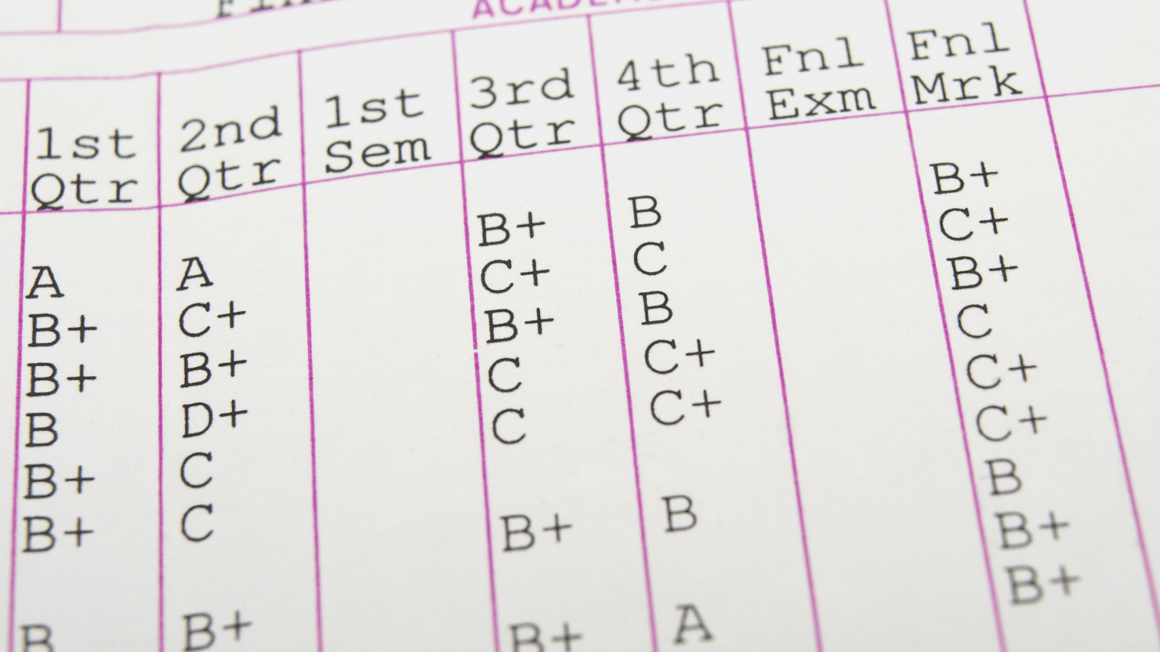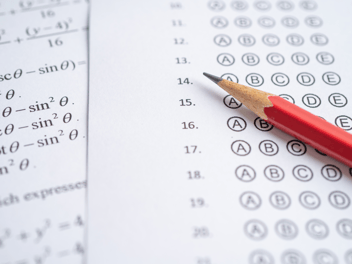

Published: August 29, 2022
Picture this: You're back in high school, anxiously awaiting the results of your final report card for the year. You get your copy, and you start scanning across each subject... an A in U.S. history, another A in literary studies, a B in algebra — then, all of a sudden, BAM! A big C- in chemistry. "How did this happen?" you ask yourself. "It was a B last quarter!"
Even if this wasn’t your personal experience with chemistry, you’ve likely been surprised by a sudden bad grade with no way of knowing what went wrong. An A demonstrates mastery of a given subject, but what about the other letters in the grading system? Sure, they show areas to work on, but what concepts specifically need improvement? This is where the traditional grading system falls flat, leaving students and families confused and disheartened.
One solution for providing this much-needed transparency into student performance is by transitioning to standards based grading. This innovative grading system can help teachers like you dive deeper into student skill gaps to surface with insights that drive academic achievement.
What is Standards Based Grading?
Standards based grading (SBG) is a new way of measuring student progress and mastery against state learning standards. By dividing subjects or courses into smaller critical learning targets, you're able to precisely identify where learning is progressing and where comprehension falls off for each student. With this information, you can tell a more detailed story of every student’s academic capabilities, helping students, parents, and other teachers better understand a student's learning progress.
According to a study from the National Association of Secondary School Principals, teachers agreed that standards based systems made planning, instruction and assessment more purposeful and effective. Because this grading practice emphasizes mastery of specific skills and concepts over a generalized letter grade, your students can see where exactly they need to improve, motivating them to reach the potential you see every day.
How Does it Differ From Traditional Grading?
Comparing traditional letter grades to standards based grades is like comparing reading glasses to a microscope. Instead of a single letter without much context, a standards based report card has multiple standards categories for each academic subject, using a grading scale of typically 1-4 to report student grade-level mastery of a given standard.
Here’s an example of what a normal report card grade might look like compared to one from a school that practices standards based grading:
| Traditional Grading | Standards Based Grading | ||
| Social Studies | A | ---Social Studies--- | 3 |
| Construct meaningful questions | 3 | ||
| Connect past concepts to the present | 2 | ||
| Gather and evaluate sources | 3 | ||
| Develop claims using evidence-based reasoning | 3 | ||
| Communicate and critique conclusions | 4 |
In a standards based grading system, the number scale reflects the level of student mastery, with Ones indicating a lack of understanding and Fours demonstrating an exceeded target. But how do teachers assess student mastery based on this scale?
Guiding Student Learning With Standards Based Grading
Despite its apparent simplicity, the 1-4 SBG scale is actually a doorway to all kinds of student learning data. The key is to divide each subject into the core standards and concepts that can be easily measured on the proficiency scale. Plus, after reporting periodic learning progress on a standards based grade scale, you can address any concerns, adapt your instruction to students' needs, and guide them through any missed concepts with precision and purpose.
On board so far? Here's a three-step process outlining how it works:
1. Accurately Measure Learning Progress
The first step to guiding student learning with SBG is to start collecting data on performance and progress against each state standard. Formative assessments are often the perfect tool for the job, as they can given frequently to measure understanding daily or weekly. Once you review these assessments, you can analyze progress toward core concepts and standards to see how each student is performing. These demonstrations of student learning ultimate come together to become a student's grade against that standard or skill. You can also aggregate classroom data to gather broad insights for lesson adjustment and reteaching.
2. Provide Effective Feedback
Once you've got your data in hand, it's easy to see the advantages of standards based grading. These reports on student progress enable far more effective and constructive feedback for families than a single, periodic letter grade. And, with multiple categories scored across a comprehensive rubric, you can precisely address skill and knowledge gaps to support each student's success. Standards based grading also empowers students to better understand their opportunities for improvement. Not only does this help them pursue mastery of all their grade-level standards, but it also motivates them to keep at it.
3. Deliver Optimized Instruction
Traditional classrooms often present the curriculum in a way that sometimes leaves students scratching their heads while teachers move on. Instead, schools that practice standards based grading offer the flexibility to accommodate different learning pathways. Using the performance data you gather, you can easily identify students who need support and make informed decisions on future instruction. You'll know which students are sitting at a level one, two, three and four at any given time. And you can adjust and differentiate your instruction to help each individual or group level up. That way, you can provide targeted support for those that need it and accelerating activities for students exceeding grade level expectations.
The Importance of Data
Data is absolutely critical for any grading system, but especially when grading based on standards. Because this system breaks down courses by discrete concepts, you'll need to gather assessment data for each learning target as students progress through the course or year. By combining SBG practices with data-driven instruction, you can use these student progress insights to identify targeted areas for improvement, adapt your teaching tactics and communicate learning outcomes to students, staff and families.
Best Practices for Data-Driven Standards Based Grading
To truly drive your standards based grading approach with data, you'll need to integrate the new grading scale into your student data platform. That means aggregating all assignments—from homework and quizzes to tests and exams—and comparing them against each learning standard. Done manually, this requires an enormous spreadsheet, a lot of time and an inordinate amount of patience.
With a student data platform, it's easy to streamline this process. Gather, analyze and report on student progress metrics across multiple standards — all from a single location. This three-step cycle is similar to data-driven instruction, enabling greater insights into student learning targets. However, there are a few best practices to follow to optimize this process for standards based grading:
Collect and Assess Detailed Learning Data
Just like data-driven instruction, SBG relies on a lot of tagged learning data. With each assessment you deliver and review, it's important to identify connections with your state's standards. That means tagging each assignment or assessment with the aligned standards students are practicing. By collecting and analyzing this data, you can uncover comprehension deficits and develop targeted interventions for each student and standard. Plus, your students and their families will know exactly what they can work on to boost achievement.
Collaborate With Other Teachers and Leaders
As a teacher, you know better than anyone that quality learning thrives on collaboration. Creating a shared space for information and ideas is vital not just for student success, but teachers' professional learning as well. According to a study published in Educational Administration Quarterly, teachers find regular collaboration to be incredibly helpful, enabling better instructional decisions and professional development. In the context of SBG, that means delving into your school performance data and discussing specific areas to improve upon moving forward.
Report on Learning Targets and Performance
One of the biggest benefits of standards based grading is the ability to report on incremental student progress toward standard mastery. With each course divided into these learning milestones, it's much easier to find gaps in understanding and address them faster than before. No need to wait until the next exam to assess and report on proficiency—SBG enables you to communicate student learning progress throughout the year. That way, students and their families can compare performance against grade level expectations and work together on a path toward success.
Track Your Standards Based Grading Data With Schoolytics
Measuring and evaluating student learning data for SBG shouldn't have to be a hassle. With a school data platform like Schoolytics, you can say goodbye to your progress tracking woes and hello to streamlined data wizardry.
At Schoolytics, we put our data engineers to work so you don't have to. Our all-in-one solution centralizes all of your tagged assignment data into a single location for easy access and collaboration. Real-time dashboards provide comprehensive visibility into student mastery of individual standards, so you can quickly report progress, provide in-depth feedback and optimize your next lesson plan.
Interested in learning more? We have a free sign-up for teachers, or schedule a demo for your district!
Related Articles



Empowering Accurate Grade Insights with Schoolytics
Grading inconsistencies pose significant challenges in K-12 education, especially when grades vary...
